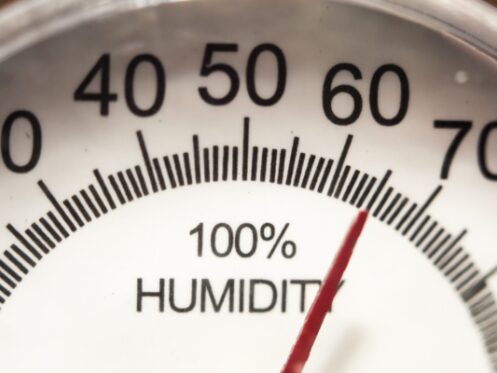Keeping your home healthy and comfortable inside means having certain devices to measure or control things. For instance, you might have a thermometer mounted on a wall or as part of a clock that tells you the temperature in your home. You also probably have a thermostat. It might show you the temperature but also lets you set the temperature you want your HVAC system to keep your home at. One device you may or may not have is a hygrometer. Hygrometers measure the level of humidity in your home, and that can make a huge impact on your comfort at any temperature.
Hygrometers Measure Humidity
Air contains moisture, but the levels aren’t always steady. Just as much as temperatures can go up or down, so too can humidity levels. Hygrometers originally started as weather instruments, but an indoor version can detect how much water vapor is in your home. The humidity level is often reported as a percentage. It might also display this as relative humidity, known as RH. Traditional hygrometers are based on dials, but contemporary units might display the local humidity level as specific digits on an LED screen. Keeping indoor humidity levels in an optimal range has many benefits, and a hygrometer means you don’t have to guess the humidity level in your home.
What’s an Ideal Indoor Humidity Level?
If you live with anyone in your home, there might be an occasional disagreement over what the temperature in your home should be. There might also be potential for disagreement about appropriate humidity levels. Unfortunately, there isn’t a set answer to this, and humidity levels can vary in their comfort from season to season. Generally speaking, a good range of humidity is 30% to 50%, although some households feel more comfortable between 40% and 60%. Keep in mind that 30% might feel rather good in the winter when it’s very dry outside, but 50% might feel good inside during the summer when it’s very moist outdoors.
The items you have in your home might also dictate where you keep your humidity levels. House plants generally thrive better in a range of 40% to 60%, while wood furniture fares best in a range of 35% to 45%. If you love cigars, they need humidity levels of 65% to 70%, which is probably going to be uncomfortable for anyone in your home; that’s why many cigar lovers store them in a humidor. Musical instruments can be especially sensitive to humidity, as pianos do best in a range of 45% to 60%, while guitars should be stored at 35% to 45%.
Risks of High Humidity Indoors
Excess humidity does more than make you uncomfortable. It can actually have a negative impact on your health. When the air surrounding you is too humid, your body isn’t able to use the evaporative process to regulate its temperature inside via sweat. Humid rooms feel warmer than they actually are, and they enable the growth of dust mites, fungi, and mold. All of those can result in breathing issues for anyone with allergies or asthma. High levels of humidity can attract unwanted pests and even make wood start to warp and rot.
Risks of Low Indoor Humidity
Before you crank up your air conditioner or rush out and buy a dehumidifier to try and drive your home’s humidity levels as low as possible, you need to stop to consider the impacts of low indoor humidity. Dry air might make your skin cold and itchy, which can be very uncomfortable. In fact, air that is too dry might dry out your body’s mucous membranes. That’s why you might get chapped lips and a sore throat during a winter storm. That same dry air might also cause breathing problems, such as wheezing and coughing. Low humidity levels can also make your home suffer damage from shrinking and cracking wood, particularly around molding and door frames. Wooden furniture and flooring might start creaking and even separating.
Warning Signs of Unhealthy Humidity Levels
A hygrometer can tell you where your humidity levels are indoors, but there are warning signs that you can watch out for. If you’re not sleeping well, then that can be a potential sign of humidity levels that are too high or even too low. Your body has to work harder to cool down when humidity is too high, and humidity that is too low might irritate your throat and result in coughing fits.
If you’re constantly sweating inside your home, you might get exhausted from the constant stickiness. You might be used to that outdoors in the summer, but your home should be a place of respite where you can get a break from all this. High humidity can also create breathing problems during the day.
Static electricity or dry, itchy skin can both be signs of low humidity levels. You might also notice damage to musical instruments or your wood furniture. It might seem like a benefit that your bathroom mirrors don’t fog up after a shower, but when there’s little to no condensation in your home, you might be seeing a warning sign of air that is too dry.
Managing Indoor Humidity
Lowering the humidity in your home might be as easy as turning on your air conditioning or adding a dehumidifier to particularly humid rooms. Fans can move air around to make it feel cooler and dryer and exhaust fans can pull humid air out of kitchens and bathrooms. Sealing your home up is also a good idea because it will make your HVAC work less. It also keeps moisture and humidity from seeping in.
Raising your humidity levels might not be something you think about in the spring or summer, but they can matter in colder months. For that matter, it could help during the summer. If your air conditioning is running all the time, then your home’s air might get too dry although this is a little extreme of a situation. Fortunately, adding humidity isn’t that hard.
If you wash your clothes, let them air dry inside to add moisture to the air. If you already do air-drying, then consider moving them outside if you’re trying to lower humidity. Indoor plants are another great way to add moisture and humidity to a home, and they also help purify the air when they convert carbon dioxide to oxygen.
Balance Your Home’s Humidity
You can escape the heavy, humid air that happens in the summer, but you can also avoid the itchy dryness of winter air. Your own body might tell you that the humidity in your home is off, and a hygrometer can tell you just where the humidity level actually is. HVAC technology recommended and installed by professionals can help you manage the humidity levels in your home and keep it comfortable. If you live in Floyd County, GA, contact us at Hitchcock Heating & Air about our heating, cooling, and indoor air quality services. Count on us to make your home the comfortable and healthy oasis you deserve.


